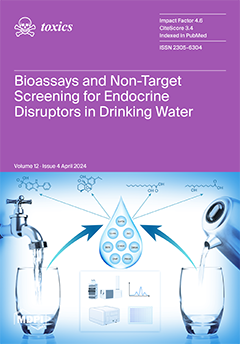This study aimed to isolate and characterise endophytic bacteria from the pioneer plant
Ageratina adenophora in a mining area. Seven strains of metal-resistant endophytic bacteria that belong to five genera were isolated from the roots of
A. adenophora. These strains exhibited various
[...] Read more.
This study aimed to isolate and characterise endophytic bacteria from the pioneer plant
Ageratina adenophora in a mining area. Seven strains of metal-resistant endophytic bacteria that belong to five genera were isolated from the roots of
A. adenophora. These strains exhibited various plant growth-promoting (PGP) capabilities.
Sphingomonas sp. ZYG-4, which exhibited the ability to secrete indoleacetic acid (IAA; 53.2 ± 8.3 mg·L
−1), solubilize insoluble inorganic phosphates (Phosphate solubilization; 11.2 ± 2.9 mg·L
−1), and regulate root ethylene levels (1-aminocyclopropane-1-carboxylic acid deaminase activity; 2.87 ± 0.19 µM α-KB·mg
−1·h
−1), had the highest PGP potential. Therefore,
Sphingomonas sp. ZYG-4 was used in a pot experiment to study its effect on the biomass and Pb uptake of both host (
Ageratina adenophora) and non-host (
Dysphania ambrosioides) plants. Compared to the uninoculated control,
Sphingomonas sp. ZYG-4 inoculation increased the biomass of shoots and roots by 59.4% and 144.4% for
A. adenophora and by 56.2% and 57.1% for
D. ambrosioides, respectively. In addition,
Sphingomonas sp. ZYG-4 inoculation enhanced Pb accumulation in the shoot and root by 268.9% and 1187.3% for
A. adenophora, and by 163.1% and 343.8% for
D. ambrosioides, respectively, compared to plants without bacterial inoculation. Our research indicates that endophytic bacteria are promising candidates for enhancing plant growth and facilitating microbe-assisted phytoremediation in heavy metal-contaminated soil.
Full article






